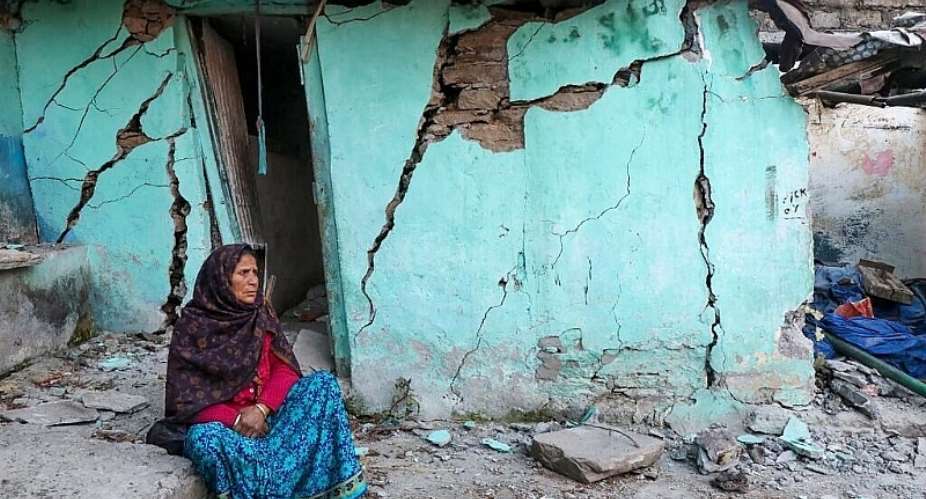On the slopes of the Himalayas, nearly 2,000 metres above sea level, the hill town of Joshimath is sinking. Experts fear it's one of many settlements in the ecologically fragile region in danger of being wiped out because of subsidence worsened by large-scale construction and climate change.
Satellite images of Joshimath, in the northern state of Uttarakhand, show that the town sank by more than five centimetres in just 12 days earlier this month, according to a preliminary report by the Indian Space Research Organisation (ISRO).
The images, released by ISRO's National Remote Sensing Centre, indicate rapid subsidence of 5.4 centimetres between 27 December last year and 8 January.
It comes after the town, located at an altitude of 1,875 metres, sank by 8.9 centimetres over the seven months between April and November 2022, said the report.
Residents evacuated
Over 280 buildings in Joshimath, including a local temple, have developed cracks since the first week of January due to land subsidence, according to government data.
The total number of buildings affected is now 849, the figures show.
The damage led authorities to begin evacuating hundreds of Joshimath's roughly 25,000 residents earlier this month.
“Cracks have developed on our walls of our courtyard and now the administration has shifted us temporarily to a primary school,” Pradeep Lal, a shopkeeper told RFI.
“We might be safe, but we worry for our cattle after the cowshed was also affected.”
The Uttarakhand government has also promised compensation for the families affected.
Extreme weather
Residents fear further damage as the meteorological department predicts rain and snowfall in the region.
Joshimath's location, on steep slopes in a seismic zone, makes it naturally vulnerable to erosion and landslides.
But experts say that climate change is aggravating the situation.
- Himalayan snows set for massive melt by 2100
- Climate-vulnerable India struck by natural disasters 'almost daily'
“The added factor of climate change is bringing more volatility because of unseasonal and extreme rain events,” Sunita Narain, director of the Centre for Science and Environment think tank, told RFI.
“The bottom line is that this region is different – it is not the plains of India which are situated on alluvial soil; it is not the Indian peninsular region where there is hard rock; it is not even the slopes of the Alps, where mountains have aged,” said Narain.
Various studies have found that glaciers in the Himalayas are melting dramatically, potentially increasing the risks of floods and landslides.
Unchecked development
Experts say that rampant development is making the fragile Himalayan ecosystem even more vulnerable to the changing climate, warning that Joshimath may be just one of many towns affected.
Years of unbridled construction, hydropower projects and the lack of a proper drainage system have all contributed to the current situation.
The Joshimath Bachao Sangharsh Samiti, an activist group agitating for the welfare of the town's residents, has accused the state government of ignoring its warnings for months.
“The crisis has endangered the very existence of a historic town, but the relief and rescue operations being carried out by the state government are devoid of any urgency,” it said in an open letter to Prime Minister Narendra Modi.
It was only in late December, when hundreds of houses were affected, that the state authorities began evacuation measures and deployed scientists to evaluate the effects of subsidence.
Activists point out that experts have been warning of subsidence in the area since at least 1976.





 'Kill whoever will rig Ejisu by-election' – Independent Candidate supporters inv...
'Kill whoever will rig Ejisu by-election' – Independent Candidate supporters inv...
 Ashanti Region: ‘Apologize to me for claiming I owe electricity bills else... – ...
Ashanti Region: ‘Apologize to me for claiming I owe electricity bills else... – ...
 Ghana is a mess; citizens will stand for their party even if they’re dying — Kof...
Ghana is a mess; citizens will stand for their party even if they’re dying — Kof...
 Internet shutdown an abuse of human rights — CSOs to gov't
Internet shutdown an abuse of human rights — CSOs to gov't
 Free SHS policy: Eating Tom Brown in the morning, afternoon, evening will be a t...
Free SHS policy: Eating Tom Brown in the morning, afternoon, evening will be a t...
 Dumsor: A British energy expert 'lied' Ghanaians, causing us to abandon energy p...
Dumsor: A British energy expert 'lied' Ghanaians, causing us to abandon energy p...
 What a speech! — Imani Africa boss reacts to Prof. Opoku Agyemang’s presentation
What a speech! — Imani Africa boss reacts to Prof. Opoku Agyemang’s presentation
 Dumsor: Tell us the truth — Atik Mohammed to ECG
Dumsor: Tell us the truth — Atik Mohammed to ECG
 Dumsor: Don't rush to demand timetable; the problem may be temporary — Atik Moha...
Dumsor: Don't rush to demand timetable; the problem may be temporary — Atik Moha...
 Space X Starlink’s satellite broadband approved in Ghana — NCA
Space X Starlink’s satellite broadband approved in Ghana — NCA
